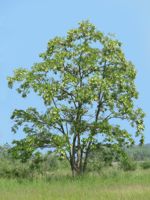Mon-Fri 9am - 5pm Mountain time
Black Locust vs Dappled Willow
Robinia pseudoacacia
Salix integra Hakuro-Nishiki
NOT AVAILABLE THIS SEASON - MIGHT RETURN
Black Locust is an attractive tree. Its distinctive leaves are made of about a dozen bright green leaflets. It also notable for its fragrant white flowers, which smell of citrus.
Black Locust can grow in many situations, but prefers dry areas with lots of sun. It is robust and is an excellent choice for establishing shade in dry, open areas.
Important note: Much of the Black Locust is toxic to humans and livestock, including seeds, bark, and leaves.
Dappled Willow is a small, cold hardy shrub with unusual beauty. Its leaves are pink in spring, maturing into variegated shades of pink, white and green. After losing their leaves in autumn, the stems maintain a rich red color throughout the winter. For a splash of color, try Dappled Willow on its own or as a hedge.

